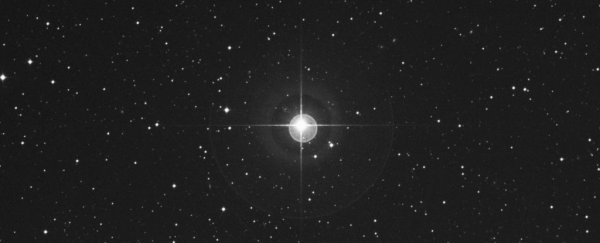Astronomers recently discovered that a long time ago, a collision with a satellite galaxy did something interesting to the Milky Way, puffing up its disc and seeding its halo with stars. Now, we've established a more precise time frame for that event, all thanks to a single star.
That star is visible in the night sky. It's called Nu Indi (HD 211998), located just 94 light-years away in the southern constellation of Indus. Through a combination of accurate galactic mapping data, spectroscopy, stellar kinematics and asteroseismology, observations of this singular star have now revealed our galaxy's violent past.
The satellite galaxy, Gaia-Enceladus (also known as the Gaia Sausage), was the largest satellite galaxy ever devoured by the Milky Way, as far as we can tell. It was discovered in data from the ongoing Gaia galactic survey, the most accurate 3D map of the Milky Way's stars.
Those data included the proper motion of the stars as they whirl about - revealing, on careful study, a population of stars moving together propelled by the collision. Further analysis suggested the collision took place between 8 and 11 billion years ago (the Universe is around 13.8 billion years old).
Enter Nu Indi, an old, metal-poor star about three times the size of our Sun, but only 85 percent of its mass. Spectroscopic analysis of its chemical composition indicates that it was born right here in the Milky Way; but, according to the Gaia data, its movement through the galaxy was altered by the Gaia-Enceladus collision.
"Since the motion of Nu Indi was affected by the Gaia-Enceladus collision, the collision must have happened once the star had formed," explained astrophysicist Bill Chaplin of the University of Birmingham. So, if you can place the age of the star, you can place constraints on when the collision occurred.
Metallicity - how rich in metal content a star is - can take you some of the way. We know that metals didn't exist until some stars had already lived and died, creating heavy elements as they exploded in supernovae. These elements were then incorporated into subsequent generations; the fact that Nu Indi only has about 3 percent of the Sun's iron abundance indicates it's pretty old.
But asteroseismology can reveal precise details about a star's properties; the method is based on the oscillation frequencies of stars, or pulsations in their intensity. These oscillations are closely linked to the properties of the star's interior, such as its density and acoustic profile; in turn, these are related to the star's mass and age.
Previous asteroseismological study of Nu Indi in 2006 gave an age estimate of over 9 billion years. But now a more powerful tool has studied the star's faint pulses: TESS, NASA's space-based exoplanet-hunting telescope launched in 2018. And asteroseismological data from TESS indicate that Nu Indi is around 11 billion years old.
If you allow time for the merger to propagate through the galaxy, this means that the collision had to have started between 11.6 and 13.2 billion years ago, the researchers said.
What makes this conclusion so cool isn't just that it shows how versatile and powerful a tool TESS is, but how many different techniques were required to arrive at the result. TESS was one part of the puzzle.
Stellar kinematics, the study of the motion of stars through space, and astrometry, the measurement of the positions of the stars, showed how Nu Indi had deviated from a normal orbit. Spectroscopy, the analysis of a light spectrum to see which light is being absorbed and emitted by various elements, revealed the star's chemical composition.
In the end, we now have placed constraints on one of the major events in our galaxy's history, helping us to better understand the evolution of the Milky Way. And it's all based on Nu Indi.
"This study demonstrates the potential of asteroseismology with TESS, and what is possible when one has a variety of cutting-edge data available on a single, bright star," Chaplin said.
The research has been published in Nature Astronomy.
